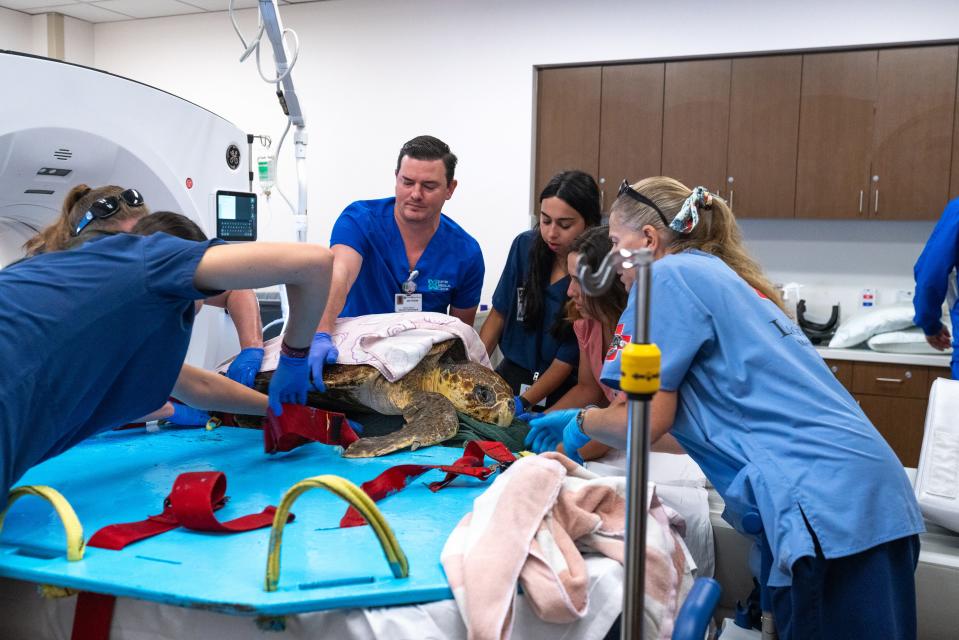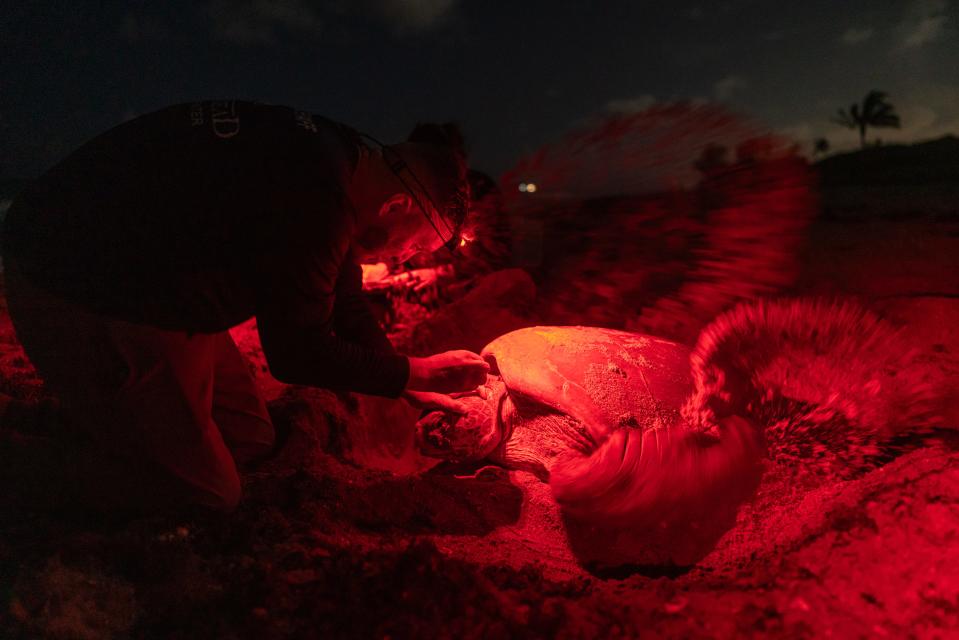Jupiter Medical Center did a CAT scan on an unusual patient: a sea turtle. Here's why.
JUNO BEACH — No doubt Jupiter Medical Center's CAT scan team has seen an array of patients cross the hospital's threshold, but in mid-May, they braced to scan perhaps their most unusual subject. Their patient had gut problems, was on an IV and being treated with antibiotics. He was also not human. He was a loggerhead turtle named Dwight.
Dwight, so named by a sponsor, was originally found in March in Vero Beach without a visible cause of stranding. Responders brought the adult male to Loggerhead Marinelife Center in Juno Beach, where Dr. Heather Barron, Loggerhead's veterinarian and chief science officer, found him to be anemic and suffering from an impacted gastrointestinal tract. She began treating him.
Within weeks, Dwight began eating on his own. But, he remained emaciated and his lower GI tract wasn't back to normal. That's when Barron turned to her colleagues who typically treat humans, ordering the CT scan at Jupiter Medical.
'Like winning the lottery': Palm Beach woman sees leatherback turtle lay eggs during the day
The trip to the hospital stretched only 7 miles, but Dwight being Dwight, the Loggerhead staff spent about a half hour just preparing for the move. They had to lower his tank water enough for staff to climb inside, slide a plank underneath him, strap him into the plank and manually lift him out. They placed the plank with Dwight secured on top onto a rolling gurney and slid the gurney into Loggerhead’s ambulance.
Once at the hospital, Barron stood behind the glass with radiologists and her team as Dwight, sedated for the process, was scanned.
The pictures promptly loaded on the screens. With multiple views, including a 3D rendering, the professionals gathered saw no signs of an issue — nothing to go in and fix. Time to pack up Dwight for the return trip. Barron forwarded the scans to an industry peer for a second look. The conclusion: clear. Dwight should be on the path to healing.
Solving one health problem does not always mean turtle is ready to return to ocean

It's possible that Dwight's problem may have started with a little too much of a tasty thing, Barron said. While living his best ocean life, Dwight may have simply found a good spot for shellfish — the diet favored by the Loggerhead species — and continued to eat without discretion.
While overeating shellfish may not pose a problem for other sea turtle species, a large amount of conch and crab ingested all at once could lead to impaction and other ailments in a Loggerhead like Dwight.
Lucky for Dwight, the treatment provided by Loggerhead Marinelife's hospital continued to relieve his digestive system. What's more, he has begun to gain weight.
Of course, healing a sea turtle is not always linear.
Dwight's gut is recovering, but he also has the marine version of bedsores. As Loggerheads can weigh anywhere up to 400 pounds and have the proportionally largest heads of turtles, Dwight’s heavy top shell, or carapace, has weighed on his neck — and his head has been resting on the bottom of the rehab tank — long enough for pressure sores to grow on his neck and jaw.
Other turtles who spend time in hard-bottomed rehab tanks have also presented with this problem. Marinelife experts at Loggerhead and other hospitals have not yet found a reliable way to prevent it. If Dwight’s pressure sores do not heal, Barron will address them surgically.
Back in the game: Gumbo Limbo in Boca Raton has new permit to treat and release sea turtles
Loggerhead Marinelife Center helps create world where people, wildlife coexist

The health issues that brought Dwight to the hospital may be considered natural hazards of life as a turtle in the ocean, like overeating and shark bites. But other turtles in the tanks at Loggerhead are rehabilitating from causes more closely tied to humans such as boat strikes, fishing line strangulations and ingesting fishing hooks.
At mid-June, Dwight was among the 100 turtles that have been brought to the center for medical attention so far this year.
Palm Beach County is “globally important,” said Justin Perrault, Loggerhead’s vice president of research, as it hosts the world’s most densely nested beaches by Loggerhead sea turtles — as well as the nation's most densely nested beaches by Green and Leatherback sea turtles.
Sea turtle nesting season is here: Images of baby turtles emerging from their nests
Throughout the year, Perrault's team spends its days parsing data about these endangered species, and during the summers, that team dedicates its nights to tracking, tagging and observing them on local beaches. The team members study issues including reproductive threats, and the correlation between pollutants and a tumor-causing virus called fibropapillomatosis found on many juvenile Green sea turtles that show up in the hospital.
Loggerhead's conservation department takes data from that research and its own fieldwork, observes hospital activities and designs programs to help prevent more sea turtles from showing up in hospitals.
Loggerhead also has teamed with non profits, local governments and property owners at 74 piers in Florida, Texas, North Carolina, Virginia and Puerto Rico to keep turtles safe particularly from damage that can happen near those structures. Through its Responsible Pier Initiative, launched in 2013, it supplies training and materials such as signs, sea turtle rescue nets and monofilament receptacles.
To date, over 800 sea turtles have been rescued through the program. Dive-cleanups have also retrieved items such as a 50-pound dumbbell and an engagement ring in the waters near piers.
Among its other ongoing initiatives, Loggerhead's Sea Turtle Protection Zone asks boaters to take voluntary precautions during sea turtle nesting season, which runs from March 1 to Oct. 31. They include cruising at slow speeds and using polarized glasses while within the first mile of the shoreline. The team charters a boat weekly from which to monitor activity near the center and promoting awareness of its goals.
The center's education team leads turtle walks on summer nights and hosts day camps to spread awareness of the marine environment, with the hope of showing people how to maintain a world where they and wildlife can co-exist.
"I think people hyperfixate on being a 'perfect environmentalist,' " said Valerie Tovar, who joined Loggerhead as a field assistant and now is its conservation manager. "No one is a perfect environmentalist. Do what you can."
This article originally appeared on Palm Beach Post: Jupiter Medical Center CAT scan helps Loggerhead turtle regain health

